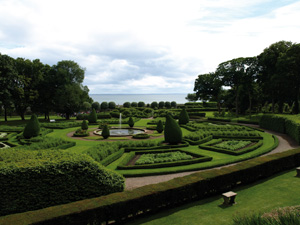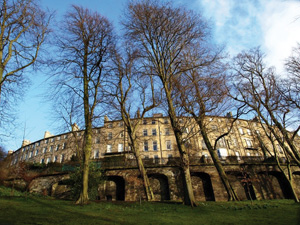Heritage Trees
 by Paul Hanson, Chairman of The Scottish Arboricultural Association
by Paul Hanson, Chairman of The Scottish Arboricultural Association
Older, mature, native and exotic trees often have the potential to be described as ‘Veteran’ or ‘Heritage’. Veteran describes those trees of extraordinary age for their species whilst Heritage alludes to some human, cultural connection e.g. folklore, religious or commemorative.
In many cases Veteran and Heritage value may well be found in the same tree. Urban, sub-urban and rural development and land management practices have created the invaluable tree reserves we enjoy today and, whilst we should hope to continue to enjoy today’s veteran and heritage trees for many years to come, we must not ignore their basic requirements. Often as a consequence of the conflict with human demands – water, sunlight, oxygen and nutrients are becoming increasingly unavailable to trees. Natural disasters, such as drought, storms and pest plagues also all play a part in the normal lifecycle of trees. However, where these are coupled with human factors – pollution, development pressures, vandalism and ill-advised pruning – what chance is there for a tree reaching a ripe old age? Old, historic man-made structures are very often accompanied, and indeed complemented, by veteran trees. Indeed, how very different some of our best known country homes and estates would look without them. Caulk Abbey, Windsor Castle and Great Park, Brodick Castle or Chatsworth House would certainly be much poorer visually without their trees and in many cases historic ‘designed’ landscapes have a deliberate, frequently unacknowledged, tree content. The ability of trees to span many generations often leads to complacency in their management and an assumption of permanence due to their longevity. Whilst the need for expertise and financial support in the conservation and maintenance of the fabric of heritage buildings is readily understood, unfortunately similar needs in relation to trees, which are frequently older than adjacent structures, are often overlooked.
Old, historic man-made structures are very often accompanied, and indeed complemented, by veteran trees. Indeed, how very different some of our best known country homes and estates would look without them. Caulk Abbey, Windsor Castle and Great Park, Brodick Castle or Chatsworth House would certainly be much poorer visually without their trees and in many cases historic ‘designed’ landscapes have a deliberate, frequently unacknowledged, tree content. The ability of trees to span many generations often leads to complacency in their management and an assumption of permanence due to their longevity. Whilst the need for expertise and financial support in the conservation and maintenance of the fabric of heritage buildings is readily understood, unfortunately similar needs in relation to trees, which are frequently older than adjacent structures, are often overlooked.
It is thought that 80% of Europe’s ancient trees reside in the UK, most within 20 miles of a town or village, with many of the oldest being associated with places of worship. Indeed, Europe’s oldest tree (perhaps), the ‘Fortingall Yew‘ in Perthshire, may be in excess of 4,000 years old. How does that equate with the perception of ‘old’ in terms of man-made structures? The sustainable management of this invaluable natural resource requires planning to ensure appropriate and adequate legal protection and this must be supported through education and municipal funding. We must encourage cyclical maintenance programs and provision for replacement in order to set in place the foundations for tomorrow’s heritage trees and landscapes. Old trees have never been more ‘popular’ than they are today and we have seen the formation of increasing numbers of well intentioned, local and national ‘old tree’ groups and societies over the last ten years. The number of high quality publications, illustrating wondrous national and international old trees, is nothing short of astounding, given the level of general public interest only ten years ago. Clearly, veteran and heritage trees are on the public green agenda and the ‘feel good’ factor continues to grow. Surprisingly, one anomaly in the growth of old tree appreciation is the absence of a corresponding development amongst our nation’s professional facilities managers. Heritage and historic landscape managers, property and conservation managers, and the organisations in which they work, have been very slow to realise the importance of the veteran and ancient trees in their care and the responsibility they have for them. They have been slower still to embrace the techniques and expertise available, through which such trees can be properly conserved.
Old trees have never been more ‘popular’ than they are today and we have seen the formation of increasing numbers of well intentioned, local and national ‘old tree’ groups and societies over the last ten years. The number of high quality publications, illustrating wondrous national and international old trees, is nothing short of astounding, given the level of general public interest only ten years ago. Clearly, veteran and heritage trees are on the public green agenda and the ‘feel good’ factor continues to grow. Surprisingly, one anomaly in the growth of old tree appreciation is the absence of a corresponding development amongst our nation’s professional facilities managers. Heritage and historic landscape managers, property and conservation managers, and the organisations in which they work, have been very slow to realise the importance of the veteran and ancient trees in their care and the responsibility they have for them. They have been slower still to embrace the techniques and expertise available, through which such trees can be properly conserved.
The practical management options for individual specimen and small groups of trees may differ considerably from those employed in traditional amenity, woodland or commercial forest settings. The growing public awareness and increasing professional involvement in the management of ‘old’ trees has led to significant changes and new developments in the techniques engaged to ensure the continued wellbeing of both the trees themselves and the associated flora and fauna. Having revisited historical management principles and practices, and combined them with the best of modern technology, we are now in a position to deliberately conserve these unique trees and their associated habitats.
• Paul Hanson is Managing Director and Company Secretary of Arboretum Internationale. For more information about them visit www.arboretum-intl.com













